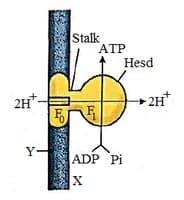Aerobic Respiration
Aerobic Respiration: Overview
This topic covers concepts such as The Respiratory Balance Sheet, Amphibolic Pathway, Oxidative Decarboxylation of Pyruvic Acid, Kreb's Cycle, Electron Transport Chain, NADH dehydrogenase Complex, Succinate Dehydrogenase Complex, etc.
Important Questions on Aerobic Respiration
Study the given figure and select the incorrect option regarding this.

Does the Electron transport chain requires oxygen ?
What is the purpose of electron transport chain thylakoid membrane ?
What are the inhibitors of Electron transport chain?
What is the importance of Electron transport chain ?
What is Electron transport chain ?
Upon oxidation, FADH2 produces 3 ATP molecules.
In the respiratory chain of mitochondria, what is the source of electrons?
The complex I of ETC is
Describe the process of proton gradient in the mitochondria.
The transfer of electrons through the respiratory chain leads to the pumping of protons from the matrix to the _____ side of the inner mitochondrial membrane.
Name the compartment of mitochondria that becomes acidic during the electron transport chain.
Which part of the cellular respiration utilises the created FADH2 molecules?
There are 3 ATP molecules produced from the oxidation of one molecule of FADH2.
How many ATP molecules are produced after the oxidation of one molecule of FADH2?
Name the enzyme that catalyses the oxidation of NADH in ETC.
The Krebs cycle is referred to as an amphibolic pathway.
The ultimate electron acceptor of respiration in the aerobic organism is_____
The metabolic pathway through which the electron passes from one carrier to another, is called the electron transport system and it is present in the outer mitochondrial membrane.
Match the metabolic pathways in Column I with their corresponding intermediate molecules listed in Column II
| Column I | Column II | ||
| P | Krebs cycle | i | Dihydroxyacetone phosphate |
| Q | Glycolysis | ii | Succinate |
| R | Electron transport chain | iii | Cytochrome |
| S | Nitrogen fixation | iv | Glutamate |
| v | Glyoxylate | ||
Choose the CORRECT combination.
